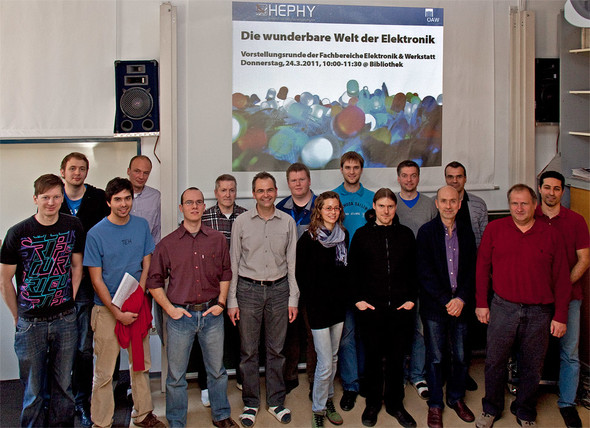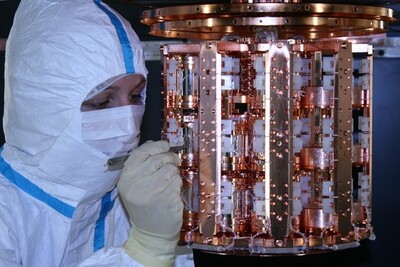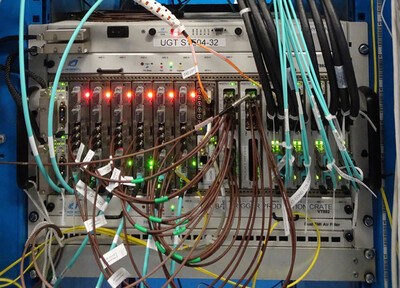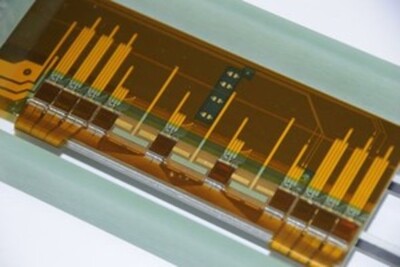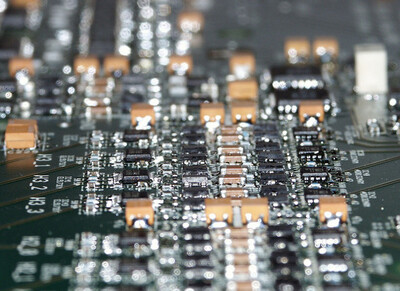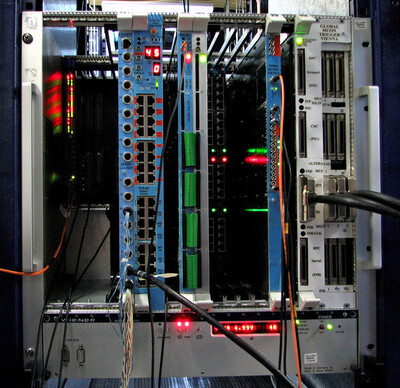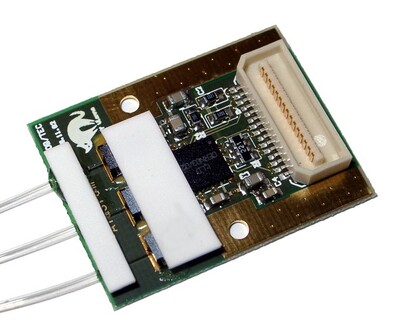The department of Electronics is responsible for developing complex electronics circuits and measurement systems for applications in high energy physics. The two main focal points are fast, low-noise analog electronics and complex programmable logic devices (FPGAs).
The development typically starts with designing electronics circuits (often a mixture of analog and digital), followed by drawing and routing the printed circuit board layout. The assembly of components can either be done manually or automatically, while programs for logic devices can be developed and programmed in parallel. Finally, the circuit is commissioned and tested extensively.
In our group, we have experts for all those tasks, and thanks to the technical equipment, we can perform all the above tasks in-house by ourselves. The typical turn-around time is a couple of months, depending on the complexity.
CRESST operates detectors at 10mK - just slightly above absolute zero. These sensors interact with energetic elementary particles and deliver signals which can be related to the type of particles and the nature of the interactions. The reason for operating sensors at low temperature is the reduction in thermal noise, which is proportional to the square root of the absolute temperature.
By 2020, the CRESST collaboration expects to have installed 5 time more detectors than in the current setup. To operate the detectors, a fully new readout system is required. At HEPHY, we are designing and building a system of one thousand ultra-low noise current sources that will operate the cryogenic detectors in the next years.
The Global Trigger Upgrade is a vital part of the Phase I upgrade of the CMS trigger system. It helps the CMS detector to effectively take data after the performance of the LHC was increased in 2015.
Modern technology like MicroTCA and the powerful Xilinx Virtex-7 FPGA chip family makes it possible to select interesting events out of 800 million proton-proton collisions every second. A scalable and modular design of the Global Trigger system allows for distribution of the resource-hungry implementation of the physics algorithms over up to six MP7 AMC modules.
The upgraded Global Trigger includes a collection of new and complex physics algorithms such as mass and topological functions. Also the number of parallel Trigger Conditions was increased to 512.
HEPHY is responsible for development and maintenance of the front end part firmware for the new Pixel FED. The front end firmware was designed to meet the following performance requirements:
- automatically find and follow the best sampling point for the incoming 400Mbd signal without disturbing data integrity
- perform NRZI and 5b/4b decoding
- split the multiplexed channels into two data streams
- detect TBM HEADER, TBM TRAILER, ROC HEADER markers and pixel data
- check and repair incoming data to deliver well encapsulated data packets whenever possible
- report number of various errors in the incoming data stream
- reduce data volume when back end FIFOs get nearly full
We have developed a novel scheme of silicon detector modules for the upgrade of the Belle experiment in Japan. Using the chip-on-sensor concept (where the amplifier chip sits on top of the silicon sensor), we can achieve very short interconnections and thus minimize the electronic noise. The connection to the other side of the detector is done with flex circuits bent around the edge - hence the name Origami.
Thanks to the straight alignment of all chips, we can use a single thin pipe for cooling the readout electronics, rather than duplicating the infrastructure to both sides. Consequently, we save material budget in the sensitive volume, such that particles can be measured with as little disturbance as possible.
A full-size prototype of this scheme was extensively tested both in the lab and in beam tests and performed very well. Apart from the front-end detector modules, we also design and build the full electronics readout chain for the future Belle Silicon Vertex Detector.
The data of particle tracks measured in the Silicon Vertex Detectorhave to be transmitted over about 30 meters to the electronics hut, where they are processed.
Electronics modules - similar to the CMS Pixel-FED - will be located there. At first, the incoming data will be digitized and subsequently processed by programmable logic devices (FPGAs). The function of these parts can be illustrated by an industry hall with many conveyor belts in parallel, on each of which many workers perform several tasks at the same time. Even though the clock speed of these modules is moderate (the conveyor belts move slowly), the data processing is guaranteed in real-time, which cannot be achieved by a computer with CPU despite of its higher clock speed (a single, fast worker is still outperformed by the conveyor belt hall).
The online data processing in those FPGAs includes a hit time measurement, where amplitude and timing of sampled envelope curves is determined. Thanks to this precision measurement, particle tracks can be assigned to a particular event or discarded if off-time. This concept results in a significant reduction of data, which is one of the main concerns with the Belle upgrade, where the collision rate will be significantly higher than before.
In the CMS detector, about 600 million proton-proton collisions occur every second, generating a vast amount of particles.
The huge amount of measurement data is buffered only for a short time (a few microseconds), while the Level 1 Trigger System collects selected data from sub-detectors and applies certain thresholds called Trigger Conditions. These criteria are programmed in such a way that they eventually lead to new physics, while other events without any new findings can be discarded.
The Global Trigger is responsible for this quick selection of interesting events. It can calculate 128 different Trigger Conditionsin parallel.
CMS has three different sub-detectors for measuring muons. One of those (RPC) covers the full area and serves primarily for triggering purposes, while the other two (DT and CSC) also cover the full area together, but focus on precise measurement of the muons. Trigger systems of all three components combine the measured data to muon tracks including momentum and electric charge and send that information to the Global Muon Trigger (GMT).
The GMT compares the received data of muon candidates, eliminates duplicate measurements and increases the overall efficiency by compensating inevitable geometric imperfections.
Moreover, information from the calorimeter is used to determine whether a muon originates from the collision point ('isolated muon') or from a secondary vertex and whether the characteristic muon energy was also measured in the calorimeter in the correct space region. The muon candidates are ranked and data of the four 'best' muons are eventually sent to the Global Trigger.
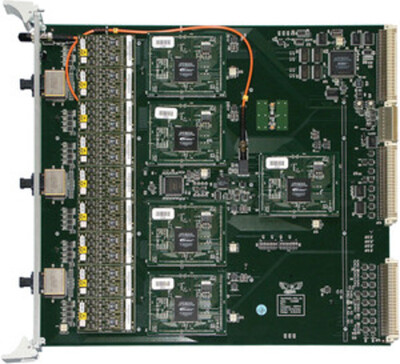
The Pixel-FED is an electronics module which receives signals of the pixel detector through its 36 optical inputs (grouped to three times a dozen) and processes them.
At first, the analog optical signals are converted to electrical and digitized. Those digital data are then sorted, processed and buffered in five programmable logic devices (FPGAs) and finally sent to the central DAQ system (PC farm) through a custom high-speed link (S-Link).
Each board processes the data of more than two millionmeasurement channels (pixels), corresponding to a throughput of more than one gigabyte per second. In contrast to a computer, the FPGAs are capable of massive parallel processing and thus a relatively low clock speed of just 40 MHz (and partly 80 MHz) is sufficient.
Both hardware and firmware (the programs within the FPGAs) were completely designed in-house. More than 50 of the Pixel-FED modules were built in the 9U VME standard, of which 40 are installed and in use in the CMS experiment at CERN. The others are spares, but also being used for further developments of the firmware.
The Analog Optohybrid is a converter from electric to optical signals, using tiny laser diodes which emit infrared light (1310nm wavelength). Different from virtually all other optical links, the data are not coded in a digital protocol here, but are actually in analog.
The dimensions of this device are just 2.3 x 3 cm2, barely larger than a Euro coin. More than 17,000 of those Optohybrids are installed in the CMS Tracker and guide all the silicon detector data through about 60 meters of optical fibers to the electronics hut, where the signals are received by more than 500 Tracker-FED modules and 40 Pixel-FEDs.
The electronics group was responsible for the layout of the Analog Optohybrid boards (with several variants containing two, three or six laser diodes) as well as the production of more than 13,000 devices, which was done at Kapsch company in Vienna. 4,000 additional devices of different types were produced in Italy.
As the Optohybrids, once installed in the CMS Tracker, cannot (easily) be accessed anymore, we laid great emphasis on production quality and testing. For the latter, we developed a dedicated test system, with which every single Optohybrid was thoroughly checked.
